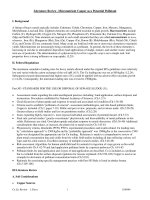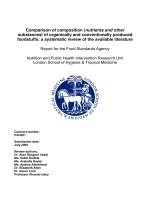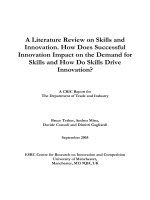LITERATURE REVIEW
Bạn đang xem bản rút gọn của tài liệu. Xem và tải ngay bản đầy đủ của tài liệu tại đây (70.13 KB, 5 trang )
7
2. LITERATURE REVIEW
2.1 BASIC CONCEPTS
Price and agricultural prices
Generally, as defined in Macmillan Dictionary of Modern Economics (Pearce, 1992: 340), “The
price of a good or input shows what has to be given up in order to obtain a good or service. It is
usually denoted in money terms although payment need not be in a monetary form.”
Agricultural product prices have some specific characteristics. According to Tomek and Robinson
(1990), how agricultural prices are determined depends on government regulations and market
conditions. In addition, prices of agricultural products are more volatile than those of non-
agricultural ones. The level of farm incomes is strongly influenced by agricultural product prices.
Farm-gate price
Farm-gate price is simply defined as the price that has farm-gate to be the pricing point. Farm-gate
has certainly been understood as the geographical site or the object who receives the price. Our
interest is the latter one. The term farm-gate price in this study reflects the one that farmers receive
although farmers sell their products at farm, at home or any other places.
Farm-gate price determination
Evidently, price is determined by the supply and demand in the market. More particularly for the
case study of cashew nut, on the basis of the price of processed cashew nut in the market either
domestic or international, the processing companies firstly determine the purchasing price of
cashew nut bean to their level 01 purchasing stations
5
. These stations accordingly decide the price
to their sellers who are purchasing stations level 02, dealers or farmers. Purchasing station level 02
and dealers in turn point out the farm-gate price of cashew nut bean to farmers. These operations
do work under a marketable manner. As most of cashew nut bean in Binh Phuoc province are
exported from processing companies; the main market factors are the exporting price of processed
cashew nut in the international market that the Vietnamese processing companies can obtain in the
international market and the volume of cashew nut bean supplied from farmers in each annual crop
and others macro factors.
Apart from these aspects, there have appeared differences in farm-gate price among farmers within
a range of change in price in each annual crop. The study focuses on this disturbance variation in
farm-gate price of cashew nut among farmers during the annual cashew nut crop. To understand
influencing factors that contribute to farm-gate price, one of popularly used methods is Hedonic
price model. Thus theories forming the environment for hedonic price model will in turn be
examined before this model is taken into account in detail.
Table 01. The disturbance variation in farm-gate price of cashew nut
Year
Variation in farm-gate price
(VND/kg)
Average price*
(VND/kg)
2003 8,200 - 6,000 7422
2004 10,000 - 7,000
2005 16,000 - 11,000
5
Purchasing station level 01 sells cashew nut bean directly to processing companies, while purchasing
station level 02 after collecting cashew nut bean from farmers or dealers, can only resells to purchasing
station level 01, not directly to processing companies.
8
2006 11,000 - 6,000 8131
Source: Informal data from the local officials
Note: *: data from survey in 2003 and 2006
Transaction Cost
Ronald Coase (in Escobal, 2001: 2), who initiates the ideas for Transaction Cost Theory, argues
that market exchange has costs. He also emphasizes the important role of transaction costs in
“contractual arrangement”. Market transactions occur based on the principle of minimizing
transaction costs. According to Escobal (2001), transaction costs can be grouped into three types:
information, negotiation and monitoring. Due to the existence of transaction costs, farmers may
have more chances to integrate into the market as transaction costs are lowered (Escobal, 2001).
Thus transaction costs are closely related to and have significant impacts on transaction among
parties including farmers and dealers, then result in certain effects on farmers’ selling price.
Market efficiency is understood as both economic and social ones such as “cost savings”,
“improvement in agency costs”, and the formation of more efficient market structures (Gu and Hitt,
2001: 85). The latter may result from either economic or social efficiency. In agricultural market,
market efficiency can be interpreted as reducing unreasonable costs occurred to both farmers and
dealers. The formation of more efficient agricultural market structures in which farmers are not inferior
also reflects the importance of market efficiency in improving farmers’ selling price.
The above theories have formed the environment in which factors affecting farm-gate prices can be
addressed in Hedonic price model.
2.2 LITERATURE REVIEW ON HEDONIC PRICE MODEL
Being popularly used, hedonic regression is a method in which the price of goods is expressed as a
function of characteristics of those goods (Silver,?; Portugal and von Oppen, 1999). Thus price is
the dependent variable and products’ characteristics are independent variables. The estimated
coefficients can be considered as contributions of those characteristics to the prices. Dummy
variables are employed to represent non-numerical characteristics of goods.
Since the study aims to examine factors affecting farm-gate price, those factors will in turn be
discussed into 6 groups: infrastructure, buyers, product, household characteristics, seasonal effects
and information.
Infrastructure
According to Harrigan et al. (1992), infrastructure development has affected producers, traders and
consumers depending on pricing and marketing systems. Due to these influences, traders often try
to bargain to lower producer prices when they have been in difficulties reaching the farm-gate.
Minten (1999) has mentioned that the distance to main road, the road quality and the access to
other infrastructure have closely been related to price variation. Communities with low level of
infrastructure incur lower prices than others with better infrastructure conditions. Minten (1999) also
concludes that an improvement in infrastructure can help to improve producer prices, to reduce
variation in price and to widen access of farmers to the market.
Buyers
Minten (1999) also discussed about the number and type of traders when examining the
determinants of market access and prices. He stated that farmers could obtain higher selling prices
when they can choose traders. Thus the more the number of traders is, the better the possibility of
farmers to choose whom to sell.
The farmers’ choice in deciding whom to sell also reflects their power in negotiating with buyers.
Escobal (2001) raised the problem of remote farmers in choosing traders since very few traders
9
come to see them. If there is only one buyer, farmers have no choice except selling their products
to that buyer. Oppositely, if there are many buyers, farmers can have an opportunity to choose the
ones they want to sell their products to. Farmers may choose this buyer instead of others due to
many reasons including the previous relation between farmers and buyers.
Product
Factors concerning about product are the quality, grading or ranking, the quantity, and types of
products sold. Referring to the price differences associated with quality, Tomek and Robinson (1990)
emphasized that the quality characteristics of agricultural products such as size, color, moisture level,
protein content, and the ratio of defects or impurities can make differences among agricultural
products. Differences in quality create difference price levels of products sold. Thus, quality is one
important factor deciding whether the selling prices are high or low.
The more abundant the quantity of a product, the lower its price is. Concerning our case, the
relationship between the quantity of products and the selling prices he can get are intended to be
analyzed. Finally, the types of products sold have also influenced the selling prices. Products can
be sold in different types such as in fresh, after being dried, before harvest time, in package and
others. Each of these types of products sold decides the selling prices that farmers receive.
Household characteristics
As mentioned in the market bargaining power of farmers, some characteristics of households will
be chosen as factors that influence the ability of farmers in negotiating with traders, then affecting
selling prices farmers get. Those characteristics cover job, educational levels, ethnicity, and
experience in cashew production of sales-decisive person.
Experience in cashew production is measured by the number of years that household heads have
been involved in cashew production. The inclusion of experience in the study implies that farmers
with a long time involved in cashew production have more bargaining power and thus obtain higher
prices than those who get less experience. According to Escobal (2001), the possibility of getting
higher selling price belongs to farmers with higher education level. Thus educational level is
expected to have a positive relationship with the bargaining power of farmers and also the selling
prices that farmers obtain. Job and ethnicity are included based on the justification that differences
in job and ethnicity will result in differences in negotiating ability of sales-decisive person.
Seasonal effects
Minten (1999) stated that agricultural production has significantly affected by seasonality. It is
expected that farmers can get higher price if they sell their products in the lean season. In contrast,
the prices they obtain will be lower in the harvest season since the products are abundant. To less
perishable agricultural products, like cashew nut, storage to get higher prices seems to be more
reasonable. However, there are also many reasons that cause farmers to sell their products
immediately in the harvest season or even before the harvest season when their products are
undervalued. Another cause of price differences over time can be accused for the differences in
production conditions, storage and transport costs (Minten, 1999). Those factors vary through time
and significantly differ between dry and rainy seasons. This is also seasonal effect that influences
selling prices of farmers.
Information
Market information is a very important factor. As discussed by NDA (?), market information can
help farmers to decide whether they should sell their products immediately or whether storage is
necessary or not. With information, farmers know where and whom to sell. They also can check on
the prices they get with the reported market prices especially in case that they sell in auction or
10
prior arrangements with traders. If the pattern of prices is going to rise up, storage can be a good
solution. In contrast, it is not necessary to keep products in store.
According to FAO (?) farmers can use information on market to check whether the prices they get
are reasonable or not. Vakis et al. (2003) conclude that transaction costs will be reduced when
farmers are informed about prices information. Concerning the bargaining power, the shortage of
information, late and inaccurate receipt of information may cause disadvantage for farmers in
negotiating with traders and make their bargaining power weak (Poole, 2001; Escobal, 2001). As a
result, farmers’ selling price can be improved based on price information attainment.
2.3 LITERATURE REVIEW ON SUPPLY CHAIN
Concept of value chain
A value chain is considered as the full range of activities to bring a product from the original
concept to the final consumer by going-through the different phases of growing and processing
(Kaplinski and Morris, 2001, p.4). Value chain analysis focuses on not only the flow of products and
services (tangible assets) along the chain, but also the flow of intangible assets (i.e. information
and knowledge) and of power relations within the chain.
Concept of supply chain
Supply chain analysis is a broadly defined as successive stages of value creation and capture in a
vertically organized set of stakeholders (Sergio et al., 2001, p.9). It includes all activities associated
with the transformation and transportation of goods from the raw materials to the end user plus the
information and financial flows.
Value - adding to agro-forestry products
Value-adding includes any process or service in the supply chain that adds to or enhances the
market value of products to customers (AFFA, p.6). Richard S. and Brendan D. (2004, p. 6)
concerned how a relative small share of the prices consumers pay for products is constituted the
prices farmers receive for the raw commodity ‘at the farm gate’. They found reasonable to ask why
the difference is so great, and what could be done to capture some of that difference by performing
activities beyond the farm gate. Thus, they consider possibilities those farmers can modify further
process or transform the basic commodities produced on farm.
AFFA (1999, p.6) pointed that value can be added in agricultural product as a result of transforming
raw products into highly processed or manufactured products, a change in the distribution between
markets; or gearing toward better meeting consumer demand. Richard S. and Brendan D. (2004, p.
6) have also emphasized indirect benefits from value –adding to farmers as follows: (i) value-
adding creates an additional business—often non-farm business; (ii) value adding potentially
results in significant changes in on-farm production as the value-added product requires specific
requirements on farming production.
However, value adding from the involvement in processes beyond the farm gate is usually attained
with the capital investment, time and employment commitment. The tasks carried out in the value
chain beyond the farm gate usually require a range of special skills and focuses, which may not
naturally reside in farmers used to dealing with the particular challenges of farm production. Adding
value to farm commodities always incurs costs as well, and the question is whether the extra value
exceeds the extra costs. Among other things, it is important whether the farmer can conduct the
value-adding task better than existing businesses.
11
‘Marketing margin’ is defined as ‘the difference between the price paid by the consumer and that
obtained by the producer’ (Tomek and Robinson, 1990). The increase in this margin is associated
with the added cost. However, the disparity between the added value and the added cost has
motivated farmers to capture higher marketing margin through the value-adding themselves. Paul
(2004) pointed that value adding performance ultimately obtains “fair” margin and price integration
along the chain.









